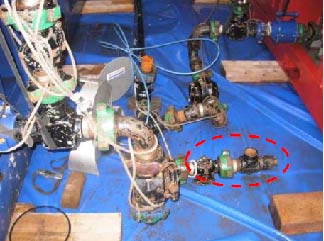Fatality during pressure test
A fatal incident has been reported which, while it took place on a drilling rig, is also relevant to many vessel operations.
During a pressure test with nitrogen, a pressure relief valve in the treating line vented. The valve was rigged up in a vertical position approximately 60cm above the height of the line. As the valve vented, the assembly rotated through 90 degrees and hit the deck of the rig. During this rotation the assembly struck a crew member on the temple causing a fatal injury.

Following investigation, the following points were noted:
- As the valve vented, the force caused the vertical stack to rotate through 90 degrees until it came into contact with the deck;
- The crew member was in the high pressure area while pressure was being applied in order to check the pressure on an instrument in the vicinity.
The following lessons were drawn from the incident:
- There should be an exclusion zone around all high pressure equipment under test. No personnel should be in this zone while pressure is being applied. Where authorised personnel do need access, this should be subject to further risk assessment and additional controls or barriers put in place. No further increases in pressure should take place whilst personnel are in the high pressure area;
- As far as possible, instrumentation in a high pressure exclusion zone should have remote viewing or monitoring capability in a low-risk area;
- When working near pressurised equipment personnel should keep clear from likely pressure release points and always out of the line of fire from vents and relief outlets;
- Equipment that could move in reaction to the sudden escape of gas under high pressure should, as far as possible, be properly secured, anchored or immobilised. All fittings and connections on pressure test equipment should be rated for the test pressure and adequately secured.
Safety Event
Published: 22 December 2009
Download: IMCA SF 18/09
IMCA Safety Flashes
Submit a Report
IMCA Safety Flashes summarise key safety matters and incidents, allowing lessons to be more easily learnt for the benefit of all. The effectiveness of the IMCA Safety Flash system depends on Members sharing information and so avoiding repeat incidents. Please consider adding [email protected] to your internal distribution list for safety alerts or manually submitting information on incidents you consider may be relevant. All information is anonymised or sanitised, as appropriate.
IMCA’s store terms and conditions (https://www.imca-int.com/legal-notices/terms/) apply to all downloads from IMCA’s website, including this document.
IMCA makes every effort to ensure the accuracy and reliability of the data contained in the documents it publishes, but IMCA shall not be liable for any guidance and/or recommendation and/or statement herein contained. The information contained in this document does not fulfil or replace any individual’s or Member's legal, regulatory or other duties or obligations in respect of their operations. Individuals and Members remain solely responsible for the safe, lawful and proper conduct of their operations.
